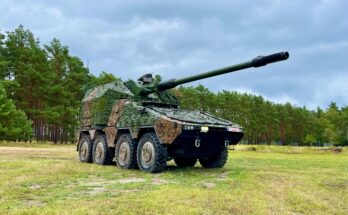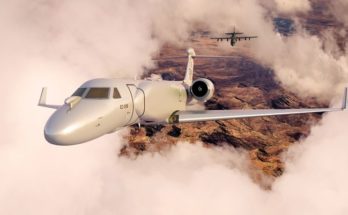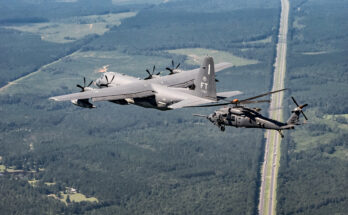
Leonardo AW609 Tiltrotor. Image – Leonardo
Leonardo successfully weathered the worst of the COVID-19 crisis, thanks to its resilient and diversified portfolio of defense and commercial programs. While commercial aerospace operations were hard hit by the pandemic, the company’s defense units were able to hold the line, minimizing the financial impact.
For 2021, Leonardo posted sales of EUR14.1 billion, up 5 percent from sales of EUR13.4 billion in 2020. The company reported net income of EUR587 million, compared with EUR243 million for 2020. The company saw growth rise above pre-pandemic levels in the defense electronics, helicopters, and aircraft sectors. The only laggard was aerostructures, which continued to be affected by the pandemic-related slowdowns in the civil aerospace market.
Helping Leonardo through the crisis was an earlier restructuring effort that aimed to achieve double-digit profitability by the early 2020s. This effort tightened project cost control and invested some EUR500 million ($624 million) in core technologies.
Defense Electronics Set to Expand
The biggest action to date in this strategy was the company’s reorganization of its electronic activities under a new division. The eponymous Electronics Division is the new umbrella for the company’s Land and Naval Defense Electronics, Airborne and Space Systems, and Defense Systems divisions. The Traffic Control Systems and Automation Systems lines of business also fall under the new division’s aegis. According to the company, the new division will be better able to compete, as its organization now mirrors that of its competitors and it has the necessary critical mass to be viable.
This unit has been further strengthened with the acquisition of a 25 percent stake in the German defense electronics producer Hensoldt. The purchase helps expand Leonardo’s geographic footprint while at the same time fostering cooperation in the European defense electronics industry. The upcoming Future Combat Air Systems programs in both the European Union and U.K. will be a key area of opportunity, as the systems will require interoperability among the allies.
Going forward, Leonardo has announced plans to continue the growth of its defense electronics operations. In early 2022, the company announced a five-year plan to grow its industrial capability in this sector, primarily in Italy. The company will invest EUR200 million in Italy (a total of EUR300 million per year when including the division in the U.K.) to develop new products and technology, modernize production lines, and strengthen its supply chain and logistics.
Key to the effort will be the “Factory of the Future” intelligent factory model, which incorporates robotics and new IT systems to deliver more efficient and sustainable production processes. In addition, the plan will see the creation of an open innovation system involving universities, technical training institutions, and research centers. This partnership effort will allow Leonardo to apply more new processes, ideas, and training modules to areas of strategic interest.
Rotorcraft Rebounding
In the rotorcraft sector, Leonardo Helicopters began to rebound – with orders moving up to 128 units, compared to 111 in 2020.
Prior to the pandemic, Leonardo Helicopters was doing quite well thanks to program wins for the NH90 and key wins in the U.S. The helicopter unit scored a major upset when its MH-139 Grey Wolf was selected as the winner of the U.S. Air Force’s UH-1N Huey replacement program. The helicopter is based on the AW139 and is offered by Boeing as prime contractor. Leonardo assembles the helicopters at its northeast Philadelphia plant, with Boeing integrating military-specific components at its Ridley Park facility south of the city. With success begetting success, in early 2020 the company was selected by the U.S. Navy to provide 32 TH-73A training helicopters. These wins give Leonardo a solid win in the U.S. market after years of disappointment.
As it seeks to build its presence in the rotorcraft market, Leonardo has expanded its portfolio with the $185 million takeover of Kopter. The company said that this move allows Leonardo to further strengthen its position in the rotorcraft sector. Kopter’s SH09, a new single-engine helicopter, allows Leonardo to quickly and easily expand its product base in a sector in which it previously had minimal exposure. The SH09 was rebranded as the Leonardo AW09 in April 2021. With this further-enlarged product range, Leonardo is aiming to gain more market share in the civil sector as the recovery winds on.
The company has also revived the Agusta brand as part of a new marketing effort aimed at VIP customers. The new initiative will offer “a unique combination of best in class performance, comfort and refined Italian style.” The brand will not only be a starting point for bespoke helicopter services, but it will also make the company’s entry into the urban air mobility market stand out.
In military rotorcraft, the company, along with Airbus, is looking to counter new programs under development in the U.S. The United States is moving forward with a bevy of new designs under its Future Vertical Lift effort, with billions invested. In order to not get squeezed out of the future market, Airbus and Leonardo, along with European governments, need to accelerate rotorcraft efforts such as NATO’s Next Generation Rotorcraft Capability program. While military development and production are key to maintaining a competitive capability, they also benefit commercial production as the technologies trickle down.
Aerostructures Struggles
Despite the current difficulties at its Aerostructures unit, Leonardo has said that it will remain a core business in the long run. That statement follows speculation that the company might divest the operation due to ongoing difficulties brought on by the pandemic and Boeing’s beleaguered 787 program, which is a major program for the unit. As it works through this difficult period, the operation has been restructured through layoffs and productivity improvements.
In addition to the 787, the firm produces large structural components for a variety of commercial aircraft such as the 767, ATR, A321, and A220 and for military platforms such as the F-35, Eurofighter, and C-27J. With vaccine distribution increasing and air travel returning, the company is looking forward to the nascent recovery. This period is expected to take place slowly in the civil market, which will not return to pre-pandemic levels before 2023 and potentially not until 2025.
Looking ahead, the company is working on two new European new-generation defense projects: Tempest with the United Kingdom, Sweden, and Italy and the MALE2025/EuroMALE UAV program in partnership with Airbus and Dassault. In addition, the recent acquisition of a stake in Germany’s Hensoldt could see Leonardo leading efforts to make the Tempest (U.K.) and FCAS (Europe) fighters’ electronic systems more interoperable.
Divestments in the Works
At the company’s semi-autonomous U.S. subsidiary, Leonardo DRS, the future is muddled following a canceled IPO attempt in early 2021. The company had hoped to raise $807 million through a sale of about a 22 percent stake in the division, with Leonardo maintaining ownership with a 78 percent holding. In September 2021, Leonardo said that it still plans to list the unit, once market conditions are right. This could occur soon, as the Russian invasion of Ukraine has rekindled defense spending goals in the U.S. and many NATO countries. Should a listing go forward, it will mark the end of a long chapter for DRS, which has been a storied purchase for the firm.
DRS was acquired for $5.2 billion in 2008, shortly before the financial crisis. The value of the deal has since plummeted, with DRS’s sales reported at $2.2 billion for 2021 in Leonardo’s annual report (lower than Leonardo may like, but much improved over past-year results of $1.8 billion). As a result, DRS underwent significant cost-cutting through both divestitures and layoffs, reducing its employee count from a high of 10,000 to about 6,700 currently. This restructuring appears to be paying off, as DRS sales have begun trending upward and increased growth in the U.S. has led to several facility expansions. At this juncture, the diminishment in its stake may have more to do with cash conversion measurements brought on by the COVID-19 pandemic.
In early 2022, Leonardo DRS announced it was selling its satellite communications services unit, Global Enterprise Solutions, to SES for $450 million. According to company officials, Leonardo DRS has shifted its portfolio focus, and selling it now makes the most business sense.
Another disposal may see Leonardo divest its Oto Melara and WASS operations. Oto Melara produces ordnance systems for land and sea applications and WASS manufactures torpedoes. According to an August 2021 report, Fincantieri was in talks over a possible acquisition of the units. A later report stated that KMW+Nexter Defense Systems (KNDS) was also interested. In March 2022, Rheinmetall also expressed interest in buying a stake, in partnership with Fincantieri, as part of a move to expand into Italian markets. However, plans are now reportedly on hold due to the war in Ukraine.
The actions undertaken so far make it clear that the strategy of Leonardo’s management is correct. Not one to be idle, the company is currently pursuing its latest strategic effort, Leonardo 2030. This effort is composed of three pillars: “strengthen the core, transform to grow, and master the new.” Simply put, the new strategy aims to improve the company’s speed, flexibility and innovation as it approaches the next decade.
Forecast International’s Defense & Aerospace Companies, Volume II – International service includes coverage of over 90 top companies and subsidiaries outside North America, with a focus on key players in Europe and Asia. Each of the volume’s 50+ reports contains data on recent programs, mergers, and joint ventures. Among the notable corporations covered are OEMs such as Airbus, Aviation Industry Corporation of China (AVIC), BAE Systems, and Embraer. Also featured are Tier I and Tier II contractors such as Rolls-Royce, Hanwha, Rafael, RUAG, and IHI Corporation. Click here to learn more.
A military history enthusiast, Richard began at Forecast International as editor of the World Weapons Weekly newsletter. As the Internet grew in importance as a research tool, he helped design the company's Forecast Intelligence Center and currently coordinates the EMarket Alert newsletters for clients. Richard also manages social media efforts, including two new blogs: Defense & Security Monitor, covering defense systems and international issues, and Flight Plan, which focuses on commercial aviation and space systems. For over 30 years, Richard has authored the Defense & Aerospace Companies, Volume I (North America) and Volume II (International) services. The two books provide detailed data on major aerospace and defense contractors. He also edits the International Contractors service, a database that tracks all the contractors involved in the programs covered in the FI library. More recently he was appointed Manager, Information Services Group (ISG), a new unit that encompasses developing outbound content for both Forecast International and Military Periscope.



